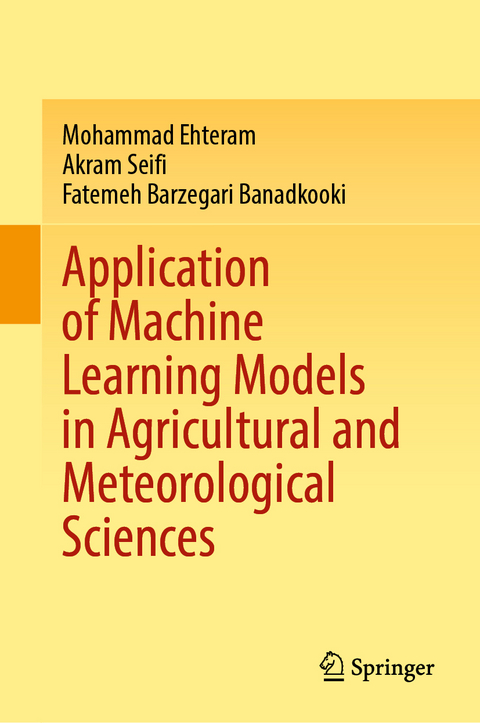
Application of Machine Learning Models in Agricultural and Meteorological Sciences
Springer Verlag, Singapore
978-981-19-9732-7 (ISBN)
Meteorological and agricultural variables can be accurately estimated with this book's advanced models.
The book explains how modelers use evolutionary algorithms to develop machine learning models.
This book is a comprehensive guide for agricultural and meteorological predictions. It presents advanced models for predicting target variables. The different details and conceptions in the modelling process are explained in this book. The models of the current book help better agriculture and irrigation management. The models of the current book are valuable for meteorological organizations.
Meteorological and agricultural variables can be accurately estimated with this book's advanced models. Modelers, researchers, farmers, students, and scholars can use the new optimization algorithms and evolutionary machine learning to better plan and manage agriculture fields. Water companies and universities can use this book to develop agricultural and meteorological sciences. The details of the modeling process are explained in this book for modelers.
Also this book introduces new and advanced models for predicting hydrological variables. Predicting hydrological variables help water resource planning and management. These models can monitor droughts to avoid water shortage. And this contents can be related to SDG6, clean water and sanitation.
The book explains how modelers use evolutionary algorithms to develop machine learning models. The book presents the uncertainty concept in the modeling process. New methods are presented for comparing machine learning models in this book. Models presented in this book can be applied in different fields. Effective strategies are presented for agricultural and water management. The models presented in the book can be applied worldwide and used in any region of the world. The models of the current books are new and advanced. Also, the new optimization algorithms of the current book can be used for solving different and complex problems. This book can be used as a comprehensive handbook in the agricultural and meteorological sciences. This book explains the different levels of the modeling process for scholars.
Mohammad Ehtearm is a researcher in artificial intelligence. He has a Ph.D. in Computer Science and a Ph.D. in Civil Engineering. His previous positions include a visiting and post-doctoral researcher at university of different universities of Canada, USA, and Poland, a manager of dam and irrigation project, manager of rehabilitation of dam and expert of stability, monitoring, and operation of dams in Isfahan Regional Water (2014-2016), a lecturer in Islamic Azad University, Kashan, Iran (2016-2018), and a manager of different projects of artificial intelligence of Iran including finding optimal location of mines and grade estimation of raw materials. His research interests generally lie in the areas application of remote sensing in water resources, water, energy, and food nexus, sustainable water resources development, extreme hydrological events, river engineering, remote sensing in water resources, dam and hydropower operation, geotechnical engineering, mining engineering, and artificial intelligence, and remote sensing in mining engineering. Akram Seifi is an associate professor at Water and Science Engineering Department of Vali-e-Asr University of Rafsanjan, Iran, with broad research interests in environmental science, water quality, and drip irrigation management, with a particular focus on artificial intelligence modeling. She holds a Ph.D. and M.Sc. degrees on Irrigation and Drainage Engineering from the Tarbiat Modares University, Tehran. Fatemeh Barzegari Banadkooki is an assistant professor at Agricultural Department, Payame Noor University, Tehran, Iran, with broad research interests in environmental science, water quality, and water resource management, with a particular focus on artificial intelligence modeling. She holds a Ph.D. on Watershed Management Science from the Yazd University, Yazd.
The importance of agricultural and meteorological predictions.- Structure of Particle swarm optimization.- Structure of Shark optimization algorithm.- structure of sunflower optimization algorithm.- Structure of Henry gas solubility optimizer.
| Erscheinungsdatum | 24.03.2023 |
|---|---|
| Zusatzinfo | 70 Illustrations, color; 4 Illustrations, black and white; XI, 196 p. 74 illus., 70 illus. in color. |
| Verlagsort | Singapore |
| Sprache | englisch |
| Maße | 155 x 235 mm |
| Themenwelt | Informatik ► Theorie / Studium ► Künstliche Intelligenz / Robotik |
| Naturwissenschaften ► Geowissenschaften ► Geologie | |
| Naturwissenschaften ► Geowissenschaften ► Meteorologie / Klimatologie | |
| Weitere Fachgebiete ► Land- / Forstwirtschaft / Fischerei | |
| Schlagworte | Climate variables • Hydrological Simulations • Machine Learning Models • Metrological Predictions • optimization algorithms • Water resource management |
| ISBN-10 | 981-19-9732-2 / 9811997322 |
| ISBN-13 | 978-981-19-9732-7 / 9789811997327 |
| Zustand | Neuware |
| Informationen gemäß Produktsicherheitsverordnung (GPSR) | |
| Haben Sie eine Frage zum Produkt? |
aus dem Bereich


